The festive month brings some of the best trout angling of the season on the New England Tablelands.
Across the region, the Summer storms freshen the creeks and the insect activity hits its straps. The trout are eager and respond to the conditions.
The downside is the hotter days for walking the streams and the prevalence of slithering things full of venom!
Regular readers will know of my affection for the fur and feather and this month I’ve decided to give a low-down on a fly box for the Summer.
If you enjoy your trout angling with lures then take note of the angling methods for each fly; it may help you to find trout under Summer conditions.
Alternatively, try flicking a fly out on a short leader attached to a clear bubble float – it works!
This pattern is the king of the eastern streams. It is high floating and a terrific option on the faster gorge waters.
The imitation is suitable for caddis, mayfly and even beetle naturals.
I invariably tie on a humpy when fishing east of the Wollomombi watershed.
On heavily overcast or raining days you’ll probably do better switching to a dark Woolly Bugger or large nymph. Colour is not critical, although most would choose green or yellow patterns.
On any of the streams west of the Wollomombi waters, this fly still reigns supreme as the dry pattern of choice.
On the slower glides of the Walcha and Guyra streams, as well as those closer to Armidale, the Red Tag continues to take plenty of trout.
Don’t be afraid to fish this pattern wet; it will induce strikes above and below the surface.
This is an indispensable fly right throughout the northern trout waters.
Dung beetles are widespread throughout the open cattle country and in the rougher gorge streams you’ll find plenty of sap sucking scarabs.
Dead-drifted down the runs, I find the foam patterns more reliable floaters than deer hair models.
This fly can be a life-saver when finicky fish are concentrating on emerging mayflies.
The size and colour of New England mayflies vary from large specimens (imitations would be a size 10) down to caenids (size 16). Black and brown are the most common although there are also a couple of orange spinners.
Do not retrieve the shaving brush; let it hang in the film.
Patience is essential with such a pattern, cast close to the most prevalent rise and wait, and wait, and wait.
Every time you lift the fly off the water to cast again increases the chance of putting and active feeder down for the afternoon.
Don’t leave home without one! The ‘Bugger’ is an essential wet pattern for fly boxes around the world.
It’s an excellent choice for the larger waters such as the Wollomombi and Macdonald systems and equally at home in the Ebor gorge country.
The patterns can imitate everything from leeches and tadpoles to crayfish. Imitations in size 8 are the best choice for general-purpose angling, although in the smaller spring-fed creeks I’ve had excellent success with smaller hook sizes around size 12.
Keep the marabou tails short and sparse. Store-bought models can easily be plucked between the thumbs, reducing the chance of short strikes and increasing tail action.
Colour is not particularly important although in dirty water I’d opt for black and under other conditions the olive pattern continues to be a wise choice.
Even barely legal-sized trout love to munch their own kind. The little epoxy minnow is a great choice, particularly early in the season when the fry have been released by angling clubs across the region.
Fished with an active retrieve adjacent to cover, this pattern is the chink in the armour of some larger fish each season.
On the native fish front, the dam action has been improving with some consistent golden perch action at Copeton and Keepit. The open flats around Copeton have produced fish on trolled smaller minnow patterns in redfin colours.
Most of the good rock and boulder gardens are still sitting high and dry so bait anglers would do well to head to the drowned timber at the top end.
Keepit continues to draw a dedicated band of carp hunters and the next couple of months are the pick of it.
Stalking the flats in knee-deep water and giving the local mud puppies some stick is a great option. Just pack a big hat and plenty of sunscreen.
Although these fish have long been the target of fly flickers, I have struck a few diehards with light bream sticks and a pocket of bright plastic grubs. Orange seems to be a killer choice and it is a marvellous way to sharpen your stalking and casting skills.
I’ve heard little from Pindari Dam and if low water and hot weather continue, we will see algae blooms slow things down.
Upstream on the Severn River there will be some cod action although you may have to do some walking. After dark is the time for the better quality fish.
The Namoi River downstream of Manilla is low but if you find the holes you may be surprised.
Spring conditions can force dam fish to move and Keepit is one of the few impoundments where fish can exit the top end under low levels.
I keep planning each Summer to canoe this section but never get organised or water levels do not coincide with the holiday period.
Down in the eastern gorges the bass should start to fire this month. I’ll be spending a week down in the guts of it over Christmas so more next month on what’s happening where.
In the January issue I’ll also be outlining the options for cod in greater detail, as well as reporting on a couple of new rigs that I’ve been experimenting with.
Reads: 5019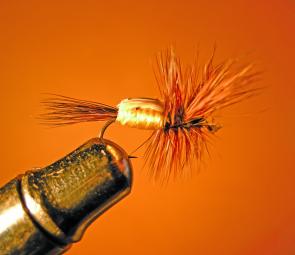
Humpy
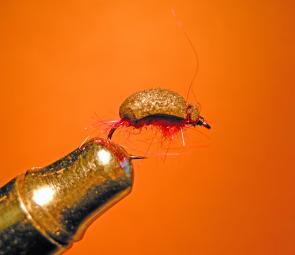
Foam beetle
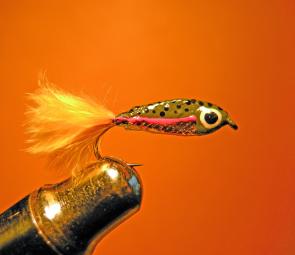
Epoxy minnow
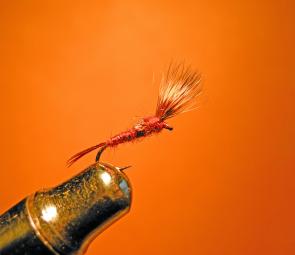
Shaving brush
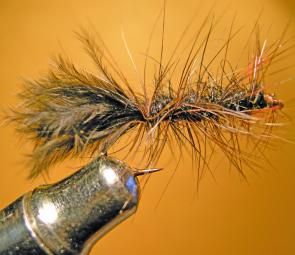
Woolly bugger
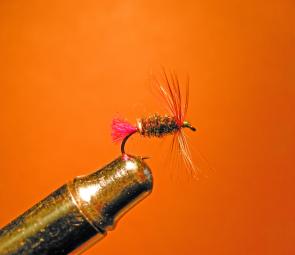
Red tag




